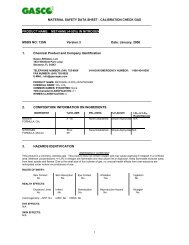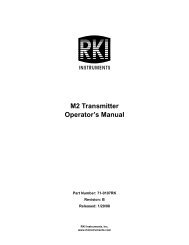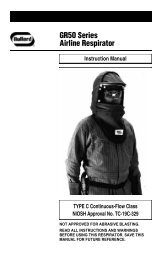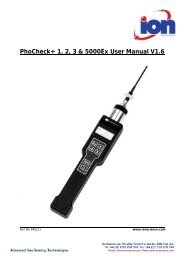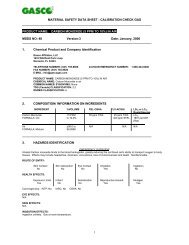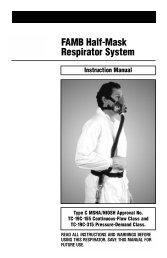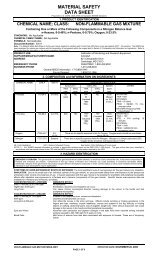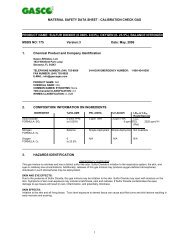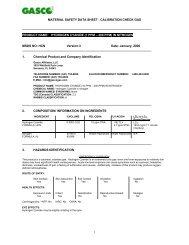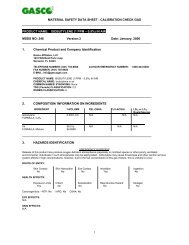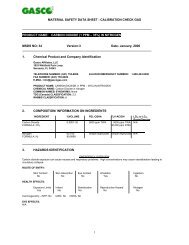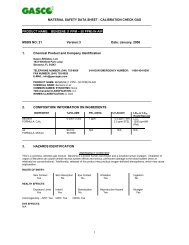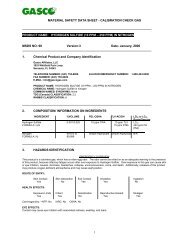Biosystems ToxiPro Manual - Ideal Calibrations
Biosystems ToxiPro Manual - Ideal Calibrations
Biosystems ToxiPro Manual - Ideal Calibrations
Create successful ePaper yourself
Turn your PDF publications into a flip-book with our unique Google optimized e-Paper software.
<strong>ToxiPro</strong> ®<br />
Single Gas<br />
Detector<br />
Reference <strong>Manual</strong><br />
0<br />
Sperian Instrumentation<br />
651 South Main Street<br />
Middletown, CT 06457<br />
(800) 711-6776<br />
(860) 344-1079<br />
Fax (860) 344-1068<br />
Part number 13-264<br />
Version 2.01<br />
31JULY2008
THE TOXIPRO ® PERSONAL PORTABLE GAS DETECTORS HAVE<br />
BEEN DESIGNED FOR THE DETECTION AND MEASUREMENT OF<br />
POTENTIALLY HAZARDOUS ATMOSPHERIC CONDITIONS.<br />
IN ORDER TO ASSURE THAT THE USER IS PROPERLY WARNED OF<br />
POTENTIALLY DANGEROUS ATMOSPHERIC CONDITIONS, IT IS<br />
ESSENTIAL THAT THE INSTRUCTIONS IN THIS REFERENCE<br />
MANUAL BE READ, FULLY UNDERSTOOD, AND FOLLOWED.<br />
<strong>ToxiPro</strong> ® Reference <strong>Manual</strong><br />
Sperian Instrumentation Part Number 13-264<br />
Version 2.01<br />
Copyright 2008<br />
by<br />
Sperian Protection Instrumentation, LLC<br />
Middletown, Connecticut 06457<br />
All rights reserved.<br />
No page or part of this operation manual may be reproduced in<br />
any form without written permission of the copyright owner<br />
shown above.<br />
Sperian Instrumentation reserves the right to correct<br />
typographical errors.<br />
1
Table of Contents<br />
Operating Temperature Range ............................................................................ 3<br />
Certifications......................................................................................................... 3<br />
ATEX Label Requirement ..................................................................................... 3<br />
Warnings and Cautions........................................................................................ 4<br />
A. Signal Words....................................................................................................................4<br />
B. Warnings ..........................................................................................................................4<br />
1. Overview......................................................................................................... 5<br />
1.1 Methods of sampling....................................................................................................5<br />
1.2 Sensors ........................................................................................................................5<br />
1.2.1 <strong>ToxiPro</strong> sensor ranges.............................................................................................5<br />
1.2.2 <strong>ToxiPro</strong> O2 sensor ranges .......................................................................................5<br />
1.2.3 <strong>ToxiPro</strong> O2 warm-up phase .....................................................................................5<br />
1.3 Alarm and warning logic ..............................................................................................5<br />
1.3.1 Gas alarms...............................................................................................................5<br />
1.3.2 Calibration and bump test due notices ....................................................................5<br />
1.3.3 Low battery alarms ..................................................................................................5<br />
1.3.4 Missing sensor during startup..................................................................................5<br />
1.3.5 Corrupt memory.......................................................................................................5<br />
1.4 Functions......................................................................................................................6<br />
1.4.1 Security beep ...........................................................................................................6<br />
1.4.2 Latching alarms .......................................................................................................6<br />
1.4.3 Silence warning alarms............................................................................................6<br />
1.5 IQ Dock Compatibility ..................................................................................................6<br />
1.6 Design components .....................................................................................................6<br />
1.7 Standard accessories ..................................................................................................6<br />
1.8 Value pack kits.............................................................................................................6<br />
2. Field Operation .............................................................................................. 6<br />
2.1 Turning the <strong>ToxiPro</strong> on ................................................................................................6<br />
2.1.1 Calibration due lockout ............................................................................................8<br />
2.2 Backlight.......................................................................................................................8<br />
2.3 Functions......................................................................................................................8<br />
2.4 Calibration and bump test due notices ........................................................................8<br />
2.5 Low battery alarms.......................................................................................................9<br />
2.6 Turning the <strong>ToxiPro</strong> off ................................................................................................9<br />
2.7 Always On Mode..........................................................................................................9<br />
2.7.1 Turning Off in Always On Mode...............................................................................9<br />
2.8 Sampling ......................................................................................................................9<br />
2.8.1 Sample draw kit usage ............................................................................................9<br />
3. Calibration.................................................................................................... 10<br />
3.1 Verification of accuracy..............................................................................................10<br />
3.1.1 Verifying accuracy and response: <strong>ToxiPro</strong> O2.......................................................10<br />
3.1.2 Verifying accuracy: <strong>ToxiPro</strong> with toxic gas sensor................................................10<br />
3.2 Effect of contaminants on <strong>ToxiPro</strong> sensors...............................................................10<br />
3.2.1 Effects of contaminants on O2 sensors .................................................................10<br />
3.2.2 Effects of contaminants on toxic gas sensors .......................................................11<br />
3.3 Fresh air/zero calibration ...........................................................................................11<br />
3.4 Functional (bump) testing (toxic sensor versions).....................................................11<br />
3.5 Span Calibration (toxic sensor versions)...................................................................12<br />
3.6 Failure to calibrate .....................................................................................................12<br />
3.6.1 Fresh air/zero calibration failure ............................................................................12<br />
3.6.1.1 Causes of fresh air/zero calibration failures..................................................12<br />
3.6.1.2 Forced fresh air/zero calibration....................................................................13<br />
3.6.2 Span calibration failure ..........................................................................................13<br />
3.6.2.1 Sensor out of range (no CAL) .......................................................................13<br />
3.6.2.2 No gas ...........................................................................................................13<br />
2
3.6.2.3 Causes for span cal failure............................................................................13<br />
3.7 Fresh air/zero calibration in a contaminated atmosphere .........................................13<br />
4. Maintenance ................................................................................................. 13<br />
4.1 Replacing batteries ....................................................................................................13<br />
4.2 Replacing sensors .....................................................................................................14<br />
4.3 Proper Cleaning .........................................................................................................15<br />
4.4 Storage.......................................................................................................................15<br />
5. PC-Instrument Communications ................................................................ 15<br />
5.1 Event logging .............................................................................................................15<br />
5.2 Instrument firmware Upgrades ..................................................................................15<br />
5.3 Initiating communications ..........................................................................................15<br />
6. Exploded view and basic parts list............................................................. 15<br />
Appendices.......................................................................................................... 16<br />
Appendix A: Sensor Cross-Sensitivity Chart..........................................................................16<br />
Appendix B: Replacement Sensor List ..................................................................................16<br />
Appendix C: Calibration Frequency Recommendation.........................................................17<br />
Sperian Instrumentation Warranty Gas Detection Products........................... 18<br />
Operating Temperature Range<br />
The safe operating temperature range of the gas detector is printed<br />
on the back label of the instrument. Use of Sperian Gas Detectors outside of the<br />
instrument’s specified operating temperature range may result in inaccurate and<br />
potentially dangerous readings.<br />
Certifications<br />
The <strong>ToxiPro</strong> ® carries the following certifications:<br />
UL and c-UL, Class I, Division 1, Groups A,B,C,D, Temp Code T4.<br />
UL Class II, Division 1, Groups E,F,G<br />
CSA Class I, Division 1, Groups A,B,C,D, Temp Code T4.<br />
CSA Class II, Division 1, Groups E,F,G<br />
ATEX Certification:<br />
II 2 G EEx ia IIC T4<br />
UL International DEMKO A/S 04 ATEX 0327520<br />
IECEx Ex ia IIC T4<br />
CQST (China)<br />
ATEX Label Requirement<br />
3
Warnings and Cautions<br />
A. Signal Words<br />
The following signal words, as defined by ANSI Z535.4-1998, are used in the <strong>ToxiPro</strong><br />
Operator’s Guide.<br />
indicates an imminently hazardous situation which, if not avoided,<br />
will result in death or serious injury.<br />
indicates a potentially hazardous situation which, if not avoided,<br />
could result in death or serious injury.<br />
indicates a potentially hazardous situation, which if not avoided, may<br />
result in moderate or minor injury.<br />
CAUTION used without the safety alert symbol indicates a potentially hazardous<br />
situation which, if not avoided, may result in property damage.<br />
B. Warnings<br />
1. <strong>ToxiPro</strong> personal, portable gas detectors have been designed for<br />
the detection of either oxygen deficiencies or specific toxic gas accumulations. An<br />
alarm condition indicates the presence of a potentially life-threatening hazard and<br />
should be taken very seriously.<br />
2. In the event of an alarm condition it is important to follow<br />
established procedures. The safest course of action is to immediately leave the<br />
affected area, and to return only after further testing determines that the area is<br />
once again safe for entry. Failure to immediately leave the area may result in<br />
serious injury or death.<br />
3. Use only Duracell Ultra #CR2, Energizer #1CR2 (EL1CR2), Sanyo<br />
#CR2 or Panasonic #CR2 in the <strong>ToxiPro</strong>.<br />
4. The accuracy of <strong>ToxiPro</strong> instruments equipped with toxic gas<br />
sensors should be checked periodically with known concentration calibration gas.<br />
Failure to check accuracy can lead to inaccurate and potentially dangerous<br />
readings. The <strong>ToxiPro</strong> O2 should be periodically calibrated in fresh air.<br />
5. A sensor that cannot be calibrated or is found to be out of<br />
tolerance must be replaced immediately. An instrument equipped with a toxic gas<br />
sensor that fails calibration may not be used until testing with known concentration<br />
test gas determines that accuracy has been restored, and the instrument is once<br />
again fit for use. Instruments equipped with an oxygen sensor that fail calibration<br />
may not be used until testing with fresh air determines that accuracy has been<br />
restored and the instrument is once again fit for use.<br />
6. Do not reset the calibration gas concentration setpoints in the<br />
<strong>ToxiPro</strong> unless the concentrations of your calibration gas differ from the<br />
concentrations of the calibration gas that is normally supplied by Sperian<br />
Instrumentation for use in calibrating the <strong>ToxiPro</strong>.<br />
7. Use of non-standard calibration gas and/or calibration kit<br />
components when calibrating the <strong>ToxiPro</strong> can lead to dangerously inaccurate<br />
readings and may void the standard Sperian Instrumentation warranty.<br />
Sperian Instrumentation offers calibration kits and long-lasting cylinders of test gas<br />
specifically developed for easy calibration. Customers are strongly urged to use<br />
only Sperian Instrumentation calibration materials when calibrating the <strong>ToxiPro</strong>.<br />
8. Substitution of components may impair intrinsic safety.<br />
9. For safety reasons the <strong>ToxiPro</strong> must be operated by qualified<br />
personnel only. Read, understand and follow the directions set forth in this<br />
reference manual before operating the <strong>ToxiPro</strong>.<br />
10. The <strong>ToxiPro</strong> has been tested for intrinsic safety in Explosive<br />
Gas/AIR (max. 21.0% O2).<br />
4
1. Overview<br />
The <strong>ToxiPro</strong> is a single sensor gas detector<br />
that can be configured to detect either oxygen<br />
(O2) or one of a variety of toxic gases. The<br />
<strong>ToxiPro</strong>’s sensor type is shown on the front of<br />
the instrument and is also shown on the<br />
display during the start up sequence. The<br />
<strong>ToxiPro</strong> includes numerous features designed<br />
to meet specific user requirements.<br />
Note: Early production runs of the oxygen<br />
version of the <strong>ToxiPro</strong> were referred to as<br />
the “OxyPro”. The instructions contained<br />
in this manual that refer to the <strong>ToxiPro</strong><br />
oxygen (O2) are also valid for the OxyPro<br />
with similar instrument firmware.<br />
1.1 Methods of sampling<br />
The <strong>ToxiPro</strong> may be used in diffusion mode,<br />
or with the manual sample draw kit that is<br />
available separately. In either mode, the<br />
atmosphere must reach the sensor for the<br />
instrument to register a reading. In diffusion<br />
mode, the atmosphere reaches the sensor by<br />
diffusing through the sensor port on the front<br />
of the instrument. Normal air movements are<br />
enough to carry the sample to the sensor.<br />
During remote sampling, the gas sample is<br />
drawn into the sensor compartment through<br />
the probe assembly and a length of tubing.<br />
See section 2.8 for more details on<br />
sampling the atmosphere.<br />
1.2 Sensors<br />
All versions of the <strong>ToxiPro</strong> except the O2<br />
model use an electrochemical toxic gas<br />
sensor. The <strong>ToxiPro</strong> O2 uses a galvanic<br />
oxygen sensor. Both types of sensor have<br />
been designed to minimize the effects of<br />
common interfering gases. These sensors<br />
provide accurate, dependable readings for<br />
gases commonly encountered in industrial<br />
applications.<br />
A sensor cross sensitivity chart is provided in<br />
Appendix A at the back of this manual.<br />
1.2.1 <strong>ToxiPro</strong> sensor ranges<br />
Specific toxic sensor ranges and resolutions<br />
are provided in the sensor replacement chart<br />
in Appendix B.<br />
1.2.2 <strong>ToxiPro</strong> O2 sensor ranges<br />
The oxygen sensor used in the <strong>ToxiPro</strong> O2<br />
has a range of 0-30% by volume.<br />
1.2.3 <strong>ToxiPro</strong> O2 warm-up phase<br />
The <strong>ToxiPro</strong> O2 requires a one-time, 15minute<br />
warm-up phase prior to initial<br />
activation. See section 2.1 for further details.<br />
5<br />
1.3 Alarm and warning logic<br />
1.3.1 Gas alarms<br />
<strong>ToxiPro</strong> gas alarms are user-adjustable and<br />
may be set anywhere within the range of the<br />
specific sensor. When an alarm set point is<br />
exceeded a loud audible alarm sounds, and<br />
the bright red LED alarm light flashes.<br />
Two oxygen alarm set points have been<br />
provided for <strong>ToxiPro</strong> O2 instruments. The<br />
danger alarm is sounded for oxygen<br />
deficiency and the warning alarm is sounded<br />
for oxygen enrichment.<br />
<strong>ToxiPro</strong> instruments equipped with a toxic gas<br />
sensor have up to four alarm set points:<br />
Warning, Danger, TWA (Time Weighted<br />
Average) (if enabled) and STEL (Short Term<br />
Exposure Limit) (if enabled).<br />
Note: In the standard <strong>ToxiPro</strong><br />
configuration with toxic gas sensors, the<br />
STEL and TWA alarms are not enabled.<br />
The STEL and TWA alarms may be<br />
enabled at the factory or through BioTrak<br />
software. Call Sperian Instrumentation for<br />
more details.<br />
1.3.2 Calibration and bump test due<br />
notices<br />
The <strong>ToxiPro</strong> includes bump test and<br />
calibration due notices.<br />
For more information on the calibration<br />
due notices, see section 2.4 below.<br />
1.3.3 Low battery alarms<br />
The <strong>ToxiPro</strong> is designed with two battery<br />
warning alarms that are activated when the<br />
battery voltage is reduced to specific levels.<br />
For more details on the battery alarm, see<br />
section 2.5 below.<br />
1.3.4 Missing sensor during startup<br />
If the <strong>ToxiPro</strong> fails to<br />
detect a sensor during<br />
startup, it will show “F 1”<br />
with the caution symbol<br />
and then shut itself off.<br />
For more details, see section 2.1.<br />
1.3.5 Corrupt memory<br />
The <strong>ToxiPro</strong> continuously<br />
monitors its onboard<br />
memory. If the instrument<br />
determines that the<br />
memory is corrupt, it will<br />
display “F 4” and proceed to shut itself off.<br />
If “F 4” is displayed, contact Sperian<br />
Instrumentation for further details.
1.4 Functions<br />
1.4.1 Security beep<br />
The <strong>ToxiPro</strong> includes a security beep that can<br />
be enabled or disabled with BioTrak software<br />
through the PC’s IrDA port. If the security<br />
beep is enabled, the <strong>ToxiPro</strong> will emit a short<br />
beep coupled with an LED flash at a specific<br />
interval to remind the user that the instrument<br />
is active.<br />
1.4.2 Latching alarms<br />
The <strong>ToxiPro</strong> includes latching alarms that can<br />
be enabled or disabled with BioTrak software<br />
through the PC’s IrDA port. With the alarm<br />
latch enabled, the audible and visible alarms<br />
will continue to sound even after the<br />
atmospheric hazard has cleared. To turn the<br />
alarm off once the hazard is no longer<br />
present, simply press the MODE button.<br />
1.4.3 Silence warning alarms<br />
The <strong>ToxiPro</strong>’s audible and vibrating (if so<br />
equipped) alarms can be turned off during an<br />
alarm condition by pressing the MODE button<br />
if this function has been enabled with BioTrak<br />
software. The visual warning alarm light and<br />
readings will continue to indicate the alarm.<br />
1.5 IQ Dock Compatibility<br />
The <strong>ToxiPro</strong> must be equipped with<br />
instrument firmware version 4.30 or higher to<br />
be compatible with the IQ Express Docking<br />
Station. The IQ Express Dock is an<br />
automatic calibration station coupled with a<br />
data management system.<br />
Instrument firmware in the <strong>ToxiPro</strong> may be<br />
upgraded at any time. See section 5.2<br />
below for details on software upgrades.<br />
1.6 Design components<br />
Case: The instrument is enclosed in a solid<br />
PC (polycarbonate) case with TPE (rubber)<br />
overmold.<br />
Figure 1: Exterior front view.<br />
Front face: The front face of the instrument<br />
houses the LCD display, MODE button,<br />
6<br />
sensor port, LED alarm and audible alarm<br />
port.<br />
LCD display: The liquid crystal display (LCD)<br />
shows gas readings, messages and other<br />
information. A built-in, manually-activated<br />
backlight allows the display to be read even in<br />
low light conditions.<br />
Visual alarm (LED) / IrDA port: A bright red<br />
LED (Light-Emitting Diode) alarm light<br />
provides a visual indication of the alarm state.<br />
The LED also functions as the IrDA port.<br />
MODE button: The large push-button on the<br />
front of the instrument is called the MODE<br />
button. The MODE button is used to turn the<br />
<strong>ToxiPro</strong> on and off, to turn on the backlight, to<br />
view the MAX, STEL (if enabled) and TWA (if<br />
enabled) screens and to initiate the automatic<br />
calibration sequences.<br />
Sensor port: The sensor port is located at<br />
the upper left corner of the instrument. A filter<br />
prevents unwanted contaminants from<br />
entering the sensor.<br />
Audible alarm port: A cylindrical resonating<br />
chamber contains the loud audible alarm.<br />
Belt Clip: The belt clip attaches to the bottom<br />
surface of the instrument.<br />
1.7 Standard accessories<br />
Standard accessories with every <strong>ToxiPro</strong><br />
include installed sensor and lithium battery,<br />
reference manual and calibration/sample<br />
draw adapter.<br />
Optional accessories include manual sample<br />
draw kit (hand-aspirated), vibrating alarm,<br />
Datalogger Upgrade and BioTrak software kit.<br />
1.8 Value pack kits<br />
<strong>ToxiPro</strong> value packs include all standard<br />
accessories, plus calibration fittings, 34-liter<br />
cylinder of calibration gas, and fixed flow rate<br />
regulator in a foam-lined, hard-shell carrying<br />
case.<br />
2. Field Operation<br />
Field operation of the <strong>ToxiPro</strong> is controlled<br />
entirely through the MODE button, which is<br />
located on the front of the instrument.<br />
The MODE button is used to turn the <strong>ToxiPro</strong><br />
on and off, to turn on the backlight, to access<br />
MAX, STEL (if enabled) and TWA (if enabled)<br />
gas readings for the current session and to<br />
initiate calibration.<br />
2.1 Turning the <strong>ToxiPro</strong> on<br />
The <strong>ToxiPro</strong> is effectively disabled when it<br />
leaves the Sperian Instrumentation factory.<br />
Upon arrival, the <strong>ToxiPro</strong>’s display will be<br />
blank. The <strong>ToxiPro</strong> O2 will show the negated<br />
horn icon.
or<br />
To initialize the instrument, press the MODE<br />
button. <strong>ToxiPro</strong> O2 models will proceed with<br />
a 15-minute countdown while the oxygen<br />
sensor stabilizes.<br />
Note: The 15-minute sensor warm-up<br />
period is only necessary for the initial<br />
start-up of <strong>ToxiPro</strong> O2 models.<br />
→<br />
When the <strong>ToxiPro</strong> O2 warm-up period<br />
concludes, the screen will be completely<br />
blank. <strong>ToxiPro</strong> models equipped with a toxic<br />
gas sensor do not require an initial warm up<br />
period.<br />
With the blank screen<br />
shown, press and hold<br />
the MODE button for 5<br />
seconds to initiate the<br />
start-up sequence.<br />
At start-up, the <strong>ToxiPro</strong> will automatically go<br />
through a basic electronic self-test sequence<br />
that will take approximately thirty seconds.<br />
During the self-test sequence, all sections of<br />
the display will be lit, the<br />
display backlight will<br />
momentarily turn on and<br />
the audible alarm will<br />
“chirp”.<br />
If the instrument fails to<br />
detect the sensor during<br />
startup, “F 1” will be<br />
displayed with the caution<br />
symbol following the<br />
display test screen.<br />
If “F 1” is shown, the instrument will<br />
automatically shut down in approximately 5<br />
seconds. See Section 4.2<br />
of this manual for<br />
instructions on accessing<br />
the sensor compartment.<br />
Once the <strong>ToxiPro</strong><br />
recognizes the sensor, it<br />
will display the software version.<br />
The serial number screens will then be<br />
shown: Note that the 6 digit serial number<br />
can not fit on a single screen, so it is shown<br />
on two screens. In this case, the instrument<br />
serial number is 481098.<br />
7<br />
→<br />
Datalogging versions will<br />
then show the “dL” screen.<br />
Once the sensor is<br />
recognized, the instrument<br />
will display the sensor<br />
type.<br />
The warning alarm level<br />
will then be displayed,<br />
followed by the danger<br />
alarm level. During the<br />
display of the warning<br />
alarm level, the LED alarm<br />
light will be flashed twice and the audible<br />
warning alarm will be sounded twice.<br />
During the display of the danger alarm level,<br />
the LED visual alarm will be flashed twice and<br />
the audible danger alarm will be sounded<br />
twice. The frequency of the audible danger<br />
alarm is higher than the frequency of the<br />
audible warning alarm.<br />
→<br />
For <strong>ToxiPro</strong> instruments with a toxic sensor<br />
and with the STEL and TWA alarms enabled,<br />
the <strong>ToxiPro</strong> will briefly show the STEL and<br />
TWA alarm levels.<br />
→<br />
If the calibration due reminder is enabled and<br />
calibration is due, the following screens will<br />
be shown.<br />
→<br />
Press the MODE button to acknowledge the<br />
calibration due reminder. If the instrument<br />
shuts off when the MODE button is pressed<br />
with “cal due shown”, then the <strong>ToxiPro</strong> is<br />
configured with calibration due lockout<br />
enabled.<br />
See section 2.1.1 below for more details<br />
on the calibration due lockout function.<br />
The Calibration Due Reminder and Lockout<br />
functions may be enabled or disabled with<br />
BioTrak Software.<br />
The current gas readings screen will then be<br />
shown. Toxic sensor models should show 0 if
the instrument is located in fresh air. Oxygen<br />
sensor models should show 20.9 in fresh air.<br />
or<br />
2.1.1 Calibration due lockout<br />
When the <strong>ToxiPro</strong>’s calibration due lockout<br />
function is enabled and calibration is due, the<br />
calibration due warning will be shown at<br />
instrument start up and can not be bypassed.<br />
The instrument must be calibrated<br />
immediately before it will show any gas<br />
readings. The calibration may be performed<br />
manually, or by placing it in an IQ Express<br />
Dock. Upon successful calibration, the<br />
<strong>ToxiPro</strong> will proceed to the current gas<br />
readings screen.<br />
The calibration due lockout function can be<br />
enabled or disabled with BioTrak software.<br />
2.2 Backlight<br />
The <strong>ToxiPro</strong> includes a backlight that is<br />
automatically turned on during an alarm<br />
condition. The backlight can also be<br />
manually activated while the current gas<br />
reading is displayed by pressing the MODE<br />
button once. When manually activated, the<br />
backlight will automatically turn itself off in<br />
about twenty seconds. If activated by an<br />
alarm condition, the backlight will remain on<br />
until the instrument is no longer in alarm.<br />
2.3 Functions<br />
From the current gas<br />
reading screen, press the<br />
MODE button once to<br />
activate the backlight.<br />
Press MODE again to<br />
scroll through the screen options.<br />
Once the backlight has been lit, press MODE<br />
once more to view the MAX gas values<br />
screen. The MAX figure represents the<br />
highest gas value reading that has been<br />
recorded by the instrument during the current<br />
operating session. <strong>ToxiPro</strong> O2 models will<br />
sequentially display both the highest and the<br />
lowest readings that have been recorded by<br />
the instrument in the current operating<br />
session.<br />
From the MAX screen, press the MODE<br />
button to view the time screen. A dot below<br />
the colon between the hours and the minutes<br />
digits indicates afternoon/evening hours (pm).<br />
8<br />
10:45 am 10:45 pm<br />
If the STEL (Short Term Exposure Limit)<br />
alarm is enabled, press the MODE button<br />
once to view the STEL reading. The STEL<br />
value displayed represents<br />
the average value of the<br />
instrument readings for the<br />
target gas for the most<br />
recently completed 15<br />
minutes of operation.<br />
If the TWA (Time Weighted Average) alarm is<br />
enabled, press the MODE button once more<br />
to view the current TWA value. TWA values<br />
are calculated by taking the sum of the<br />
instrument readings for the<br />
target gas for the current<br />
operating session in terms<br />
of parts-per-million-hours<br />
and dividing by an eighthour<br />
period.<br />
Note: Due to the nature of the TWA<br />
calculation, the TWA value can<br />
accumulate over time and may cause the<br />
instrument to go into alarm. Sperian<br />
Instrumentation recommends resetting the<br />
TWA value at the beginning of any work<br />
shift by turning off the instrument and<br />
then turning it back on again.<br />
Press the MODE button again to return to the<br />
current gas readings screen.<br />
2.4 Calibration and bump test due<br />
notices<br />
When the calibration due notice is enabled<br />
and the <strong>ToxiPro</strong> is due for fresh air calibration<br />
“0-CAL will be displayed at the bottom of the<br />
current gas readings<br />
screen along with the<br />
triangular warning symbol.<br />
When the calibration due<br />
notice is enabled and the<br />
<strong>ToxiPro</strong> is due for span<br />
calibration the calibration<br />
bottle icon will be displayed<br />
at the bottom of the current<br />
gas readings screen along<br />
with the warning symbol.<br />
The bump test due notice<br />
is designed for instruments<br />
that are processed in an IQ<br />
Express Dock. When the<br />
bump test due notice is<br />
enabled and the <strong>ToxiPro</strong> is<br />
due for a bump test, the calibration bottle<br />
icon will be displayed at the bottom of the
current gas readings screen without the<br />
triangular warning symbol.<br />
Note: If an IQ Express Dock is<br />
unavailable, a span calibration will also<br />
reset the bump test due notice.<br />
2.5 Low battery alarms<br />
When there are less than<br />
7 days of battery life<br />
remaining, the low battery<br />
icon will be lit.<br />
When there are less than<br />
8 hours of battery life<br />
remaining, the triangular<br />
warning symbol on the<br />
LCD will also be shown.<br />
When the battery reaches<br />
a level where it can no<br />
longer power the<br />
instrument, the <strong>ToxiPro</strong> will<br />
sound the danger alarm<br />
while displaying the<br />
danger, caution and<br />
battery icons.<br />
Press MODE to turn the instrument off. The<br />
battery must be replaced before the<br />
instrument can be used again. If the MODE<br />
button is not pressed, the instrument will<br />
remain in alarm for as long as it can before<br />
shutting itself off.<br />
2.6 Turning the <strong>ToxiPro</strong> off<br />
To turn the <strong>ToxiPro</strong> off,<br />
press and hold the MODE<br />
button down until the<br />
instrument chirps three<br />
times and OFF is<br />
displayed.<br />
Once OFF is displayed, release the MODE<br />
button. The instrument has been successfully<br />
turned off when the display goes blank.<br />
If Always On Mode is enabled see section<br />
2.7.1 for instructions for of turning off the<br />
<strong>ToxiPro</strong><br />
2.7 Always On Mode<br />
The <strong>ToxiPro</strong> may be configured so that it may<br />
not be turned off with the MODE button. In<br />
Always On Mode, the MODE button is used to<br />
reset the MAX, STEL and<br />
TWA calculations. Press<br />
and hold the MODE button<br />
until the instrument chirps<br />
three times and “on” is<br />
displayed.<br />
After the “on” screen, the <strong>ToxiPro</strong> will proceed<br />
through the standard startup sequence until<br />
the current gas readings screen is shown.<br />
MAX, STEL and TWA calculations will be<br />
reset.<br />
9<br />
Always On Mode may be enabled or disabled<br />
with BioTrak software.<br />
Note: The <strong>ToxiPro</strong> must be turned off to<br />
replace the battery. See section 2.7.1.<br />
2.7.1 Turning Off in Always On Mode<br />
BioTrak software must be used to turn the<br />
<strong>ToxiPro</strong> off when it is in Always on Mode.<br />
BioTrak is available at:<br />
http://www.biodownloads.com<br />
1. Open BioTrak and select <strong>ToxiPro</strong>.<br />
2. Select “Configure” in the software.<br />
3. Hold the MODE button down for about 10<br />
seconds until IrDA is shown and establish<br />
the connection with the PC.<br />
4. The Turn Off option appears at the bottom<br />
left of every page in the configuration<br />
window. Click the Turn Off button.<br />
2.8 Sampling<br />
The <strong>ToxiPro</strong> may be used in either diffusion<br />
or sample-draw mode. In either mode, the<br />
gas sample must enter the sensor<br />
compartment for the instrument to register a<br />
gas reading.<br />
In diffusion mode, the atmosphere reaches<br />
the sensor by diffusing through the sensor<br />
port on the front of the instrument. Normal air<br />
movements are enough to carry the sample to<br />
the sensor. The sensor reacts quickly to<br />
changes in the concentration of the gas being<br />
measured.<br />
It is also possible to use the <strong>ToxiPro</strong> to<br />
sample remote locations with the handaspirated<br />
sample-draw kit that is available<br />
separately. During remote sampling, the gas<br />
sample is drawn into the sensor compartment<br />
through the probe assembly and a length of<br />
tubing.<br />
2.8.1 Sample draw kit usage<br />
1. Connect the shorter section of tubing<br />
from the squeeze bulb to the sample<br />
draw adapter. Then connect the longer<br />
section of tubing from the squeeze bulb<br />
to the sample probe.<br />
2. Slide the sample draw adapter into the<br />
sensor port on the <strong>ToxiPro</strong> and secure<br />
it.<br />
3. Cover the end of the sample draw<br />
probe assembly with a finger, and<br />
squeeze the aspirator bulb. If there are<br />
no leaks in the sample draw kit<br />
components, the bulb should stay<br />
deflated for a few seconds.<br />
4. Insert the end of the sample probe into<br />
the location to be sampled.<br />
5. Squeeze the aspirator bulb several<br />
times to draw the sample from the
emote location to the sensor<br />
compartment. Allow one squeeze of<br />
the bulb for every one foot of sampling<br />
hose for the sample to reach the<br />
sensors. Continue to squeeze the bulb<br />
for an additional 45 seconds or until<br />
readings stabilize.<br />
6. Note the gas measurement readings.<br />
CAUTION: Hand aspirated remote<br />
sampling only provides continuous gas<br />
readings for the area in which the probe is<br />
located when the bulb is being<br />
continuously squeezed.<br />
Note: Each time a reading is desired, it is<br />
necessary to squeeze the bulb a sufficient<br />
number of times to bring a fresh sample to<br />
the sensor compartment and to continue<br />
to squeeze the bulb until readings<br />
stabilize.<br />
3. Calibration<br />
The <strong>ToxiPro</strong> features fully automated fresh<br />
air/zero and span calibration functions. The<br />
MODE button is used to initiate the automatic<br />
calibration sequence. Calibration<br />
adjustments are made automatically by the<br />
instrument.<br />
3.1 Verification of accuracy<br />
3.1.1 Verifying accuracy and response:<br />
<strong>ToxiPro</strong> O2<br />
To verify the accuracy of the <strong>ToxiPro</strong> O2, take<br />
the <strong>ToxiPro</strong> O2 to an area where the<br />
atmosphere is known to be fresh and check<br />
the readings. If the readings differ from those<br />
expected in fresh air (oxygen monitors should<br />
read 20.9% in fresh air), then a fresh air/zero<br />
calibration adjustment must be made as<br />
discussed below in section 3.3. If fresh air is<br />
not available, see section 3.7 below for<br />
instructions for calibrating the <strong>ToxiPro</strong> O2 in<br />
contaminated air.<br />
Sperian Instrumentation also recommends<br />
that the response of the oxygen sensor be<br />
regularly verified by any of these methods:<br />
• Expose the O2 sensor to a known<br />
concentration of gas containing less than<br />
19.0% oxygen. If the descending oxygen<br />
alarm is set to 19.5% the instrument<br />
should go into alarm a few seconds after<br />
the gas reaches the sensor face.<br />
• Process the <strong>ToxiPro</strong> O2 in an IQ Express<br />
Dock that has a cylinder of calibration gas<br />
containing 18.0% oxygen (or less)<br />
connected to the gas port and proceed<br />
with the oxygen bump test.<br />
• Breath test: Hold your breath for 10<br />
seconds, then slowly exhale directly onto<br />
the face of the sensor (in the same way<br />
10<br />
you would to fog up a piece of glass). If<br />
the descending oxygen alarm is set to<br />
19.5%, the instrument should go into<br />
alarm after a few seconds.<br />
3.1.2 Verifying accuracy: <strong>ToxiPro</strong> with<br />
toxic gas sensor<br />
Verification of accuracy is a two-step<br />
procedure for <strong>ToxiPro</strong> instruments equipped<br />
with a toxic gas sensor:<br />
Step one is to take the <strong>ToxiPro</strong> to an area<br />
where the atmosphere is known to be fresh<br />
and check the readings. If the readings differ<br />
from those expected in fresh air (instruments<br />
equipped with a toxic sensor should read 0<br />
PPM in fresh air), then a fresh air calibration<br />
adjustment must be made as discussed<br />
below in section 3.3.<br />
Step two is to test sensor response by<br />
exposing the sensor to a test gas of known<br />
concentration. This is known as a functional<br />
(bump) test. Readings are considered to be<br />
accurate when the display is between 90%<br />
and 120% of the expected values as given on<br />
the calibration gas cylinder. If readings are<br />
accurate, there is no need to adjust your gas<br />
detector. See section 3.4 for further details<br />
concerning the functional/bump test.<br />
If the readings are inaccurate, the instrument<br />
must be span calibrated before further use as<br />
discussed in section 3.5.<br />
The accuracy of<br />
<strong>ToxiPro</strong> instruments equipped with toxic<br />
gas sensors should be checked<br />
periodically with known concentration<br />
calibration gas. Failure to check accuracy<br />
can lead to inaccurate and potentially<br />
dangerous readings.<br />
See Appendix C for a discussion of<br />
calibration frequency recommendations.<br />
3.2 Effect of contaminants on <strong>ToxiPro</strong><br />
sensors<br />
The atmosphere in which the <strong>ToxiPro</strong> is used<br />
can have lasting effects on the sensors.<br />
Sensors may suffer losses in sensitivity<br />
leading to degraded performance if exposed<br />
to certain substances.<br />
The <strong>ToxiPro</strong> O2 uses a galvanic oxygen<br />
sensor, while toxic sensor versions of the<br />
<strong>ToxiPro</strong> use an electrochemical toxic gas<br />
sensor. Different types of sensors use<br />
different detection principles, so the<br />
conditions that affect the accuracy of the<br />
sensors vary from one type of sensor to the<br />
next.<br />
3.2.1 Effects of contaminants on O2<br />
sensors<br />
Oxygen sensors may be affected by<br />
prolonged exposure to "acid" gases such as
carbon dioxide. The oxygen sensors used in<br />
Sperian instruments are not recommended for<br />
continuous use in atmospheres containing<br />
more than 25% CO2.<br />
3.2.2 Effects of contaminants on toxic<br />
gas sensors<br />
Sperian Instrumentation’s “substancespecific”<br />
electrochemical sensors have been<br />
carefully designed to minimize the effects of<br />
common interfering gases. “Substancespecific”<br />
sensors are designed to respond<br />
only to the gases that they are supposed to<br />
measure. The higher the specificity of the<br />
sensor, the less likely the sensor will react to<br />
other gases, which may be incidentally<br />
present in the environment. For instance, a<br />
“substance-specific” carbon monoxide sensor<br />
is deliberately designed not to respond to<br />
other gases that may be present at the same<br />
time, such as hydrogen sulfide (H2S) and<br />
methane (CH4).<br />
Although great care has been taken to reduce<br />
cross-sensitivity, some interfering gases may<br />
still have an effect on toxic sensor readings.<br />
In some cases the interference may be<br />
positive and result in readings that are higher<br />
than actual. In other cases the interference<br />
may be negative and produce readings that<br />
are lower than actual and may even cause<br />
the instrument to display negative readings<br />
for the target gas.<br />
See Appendix A for cross-sensitivity data.<br />
3.3 Fresh air/zero calibration<br />
To initiate the fresh air/zero calibration:<br />
1. From the current gas reading screen,<br />
press the MODE button three times within<br />
two seconds to begin the fresh air/zero<br />
calibration sequence. The <strong>ToxiPro</strong> will<br />
briefly display “CAL” and then begin a 5second<br />
countdown with the 0-CAL icon lit.<br />
→<br />
2. Press the MODE button before the end of<br />
the 5-second countdown to begin the<br />
fresh air/zero calibration. The fresh<br />
air/zero calibration has been successfully<br />
initiated when the <strong>ToxiPro</strong> alternates<br />
between the following two screens:<br />
↔<br />
3. For instruments equipped with a toxic gas<br />
sensor, the fresh air/zero calibration is<br />
complete when the instrument begins a<br />
11<br />
second 5-second countdown for the span<br />
calibration. If span calibration is not<br />
required, allow the countdown to reach 0<br />
without pressing the MODE button. For<br />
further instructions concerning the span<br />
calibration of toxic sensor-equipped<br />
models, proceed to section 3.5.<br />
For <strong>ToxiPro</strong> O2 models, calibration is<br />
complete when the instrument returns to<br />
the current gas readings screen. If the<br />
fresh air/zero calibration attempt fails,<br />
proceed to section 3.6.1.<br />
Fresh air/zero<br />
calibrations may only be performed in an<br />
atmosphere that is known to contain<br />
20.9% oxygen and 0 PPM toxic gas.<br />
Performing the fresh air/zero calibration in<br />
an atmosphere that is not comprised of<br />
20.9% oxygen and 0 PPM toxic gas may<br />
lead to inaccurate and potentially<br />
dangerous readings.<br />
3.4 Functional (bump) testing (toxic<br />
sensor versions)<br />
The accuracy of <strong>ToxiPro</strong> instruments may be<br />
verified at any time by a simple functional<br />
(bump) test. To perform a functional (bump)<br />
test, do the following:<br />
1. Turn the <strong>ToxiPro</strong> on and wait at least<br />
three minutes to allow the readings to fully<br />
stabilize. If the sensor has just been<br />
replaced, it must be allowed to stabilize<br />
prior to performing a functional (bump)<br />
test. See section 4.2 for further details.<br />
2. Make sure the instrument is located in<br />
fresh air.<br />
3. Verify that the current gas readings match<br />
the concentrations present in fresh air.<br />
The reading for toxic gases should be 0<br />
parts-per-million (PPM) in fresh air. If the<br />
reading is anything other than 0 PPM<br />
proceed to section 3.3 and perform a<br />
fresh air/zero calibration before<br />
continuing.<br />
4. Apply the calibration<br />
gas as shown in<br />
figure 3.4.<br />
Figure 3.4 Proper<br />
bump-test/span<br />
calibration set-up<br />
for toxic sensorequipped<br />
instruments.<br />
Note: <strong>ToxiPro</strong> instruments equipped with<br />
a chlorine dioxide (ClO2) sensor require a<br />
chlorine dioxide generator as a calibration<br />
gas source.
5. Wait for the readings to stabilize. (Fortyfive<br />
seconds to one minute is usually<br />
sufficient.)<br />
6. Note the readings. Readings are<br />
considered accurate if they are between<br />
90% and 120% of the expected value. If<br />
the readings are considered accurate,<br />
then the instrument may be used without<br />
further adjustment. If readings are<br />
considered inaccurate, the instrument<br />
must be adjusted using the “span”<br />
calibration procedures discussed in<br />
section 3.5 before further use.<br />
3.5 Span Calibration (toxic sensor<br />
versions)<br />
Span calibration should be performed when a<br />
functional (bump) test has shown that the<br />
instrument’s gas readings are not between<br />
90% and 120% of the expected values as<br />
given on the calibration gas cylinder (as<br />
discussed in section 3.4). Prior to performing<br />
a span calibration, perform a fresh air/zero<br />
calibration as discussed in section 3.3. After<br />
successful completion of the fresh air/zero<br />
calibration, the<br />
instrument will begin a<br />
second five-second<br />
countdown with the<br />
calibration gas bottle<br />
icon highlighted.<br />
1. Press the MODE button before the<br />
countdown is complete to initiate the span<br />
calibration. The display will alternate<br />
between “GAS” and the expected<br />
concentration of calibration gas.<br />
↔<br />
2. Apply calibration gas as shown above in<br />
figure 3.4. Once calibration gas is<br />
detected, the readout will change to show<br />
the gas reading. Note that the negated<br />
horn symbol is shown at lower left to<br />
indicate that the<br />
alarms are not<br />
operating because<br />
the instrument is in<br />
calibration mode.<br />
Note: <strong>ToxiPro</strong> instruments equipped with<br />
a chlorine dioxide (ClO2) sensor require a<br />
chlorine dioxide generator as a calibration<br />
gas source.<br />
3. The calibration is fully automatic from this<br />
point on. Once the instrument<br />
successfully completes the span<br />
calibration, it will emit three short beeps<br />
and display the maximum span calibration<br />
12<br />
adjustment value for<br />
two seconds.<br />
Note: The maximum<br />
span calibration adjustment value shown<br />
is an indication of the relative health of the<br />
sensor. As a sensor loses sensitivity, the<br />
maximum adjustment level will approach<br />
the calibration gas concentration, letting<br />
you know when the sensor is losing<br />
sensitivity. Once the maximum span<br />
adjustment descends to within 10% of the<br />
calibration gas concentration, it is time to<br />
order a new sensor.<br />
4. Following successful<br />
calibration, the<br />
instrument will display<br />
the gas reading with<br />
the negated horn icon<br />
until the reading drops<br />
below the alarm threshold.<br />
Disconnect the calibration assembly<br />
immediately after calibration.<br />
Use of non-standard<br />
calibration gas and/or calibration kit<br />
components when calibrating the <strong>ToxiPro</strong><br />
can lead to inaccurate and potentially<br />
dangerous readings, and may void the<br />
standard Sperian Instrumentation Gas<br />
Detection Warranty.<br />
3.6 Failure to calibrate<br />
3.6.1 Fresh air/zero calibration failure<br />
In the event of fresh air/zero calibration<br />
failure, the “no” and “CAL” screens will be<br />
alternately displayed as shown below with the<br />
“0-CAL” segment lit. The instrument will then<br />
return to the gas reading screen.<br />
↔<br />
Following a fresh air/zero calibration failure,<br />
the triangular warning<br />
symbol will be lit and the<br />
“0-CAL” indicator will flash<br />
until a successful fresh<br />
air/zero calibration is<br />
performed.<br />
3.6.1.1 Causes of fresh air/zero calibration<br />
failures<br />
Fresh air/zero calibration failures often result<br />
from the attempt to calibrate the instrument in<br />
a contaminated atmosphere.<br />
Fresh air/zero calibration failures in the<br />
<strong>ToxiPro</strong> O2 can also result from an oxygen<br />
sensor that has failed.
3.6.1.2 Forced fresh air/zero calibration<br />
If a fresh air/zero calibration fails in an<br />
atmosphere known to be fresh, the <strong>ToxiPro</strong><br />
can be forced to fresh air calibrate as follows.<br />
1. Follow instructions 1 and 2 in section 3.3<br />
to begin the fresh air/zero calibration<br />
sequence.<br />
2. As soon as the alternating right and left<br />
0’s are shown on the screen, press and<br />
hold the MODE button.<br />
↔<br />
3. The forced fresh air/zero calibration is<br />
complete when the instrument emits three<br />
short beeps and then moves on to the<br />
span calibration procedure.<br />
Performing the forced<br />
fresh air calibration in a contaminated<br />
atmosphere will lead to inaccurate and<br />
potentially dangerous readings.<br />
3.6.2 Span calibration failure<br />
The <strong>ToxiPro</strong> is designed to recognize two<br />
distinct types of span calibration failures:<br />
failures that occur due to sensor response<br />
outside the sensor’s normal range for<br />
calibration and failures that occur when the<br />
instrument fails to recognize any calibration<br />
gas whatsoever.<br />
3.6.2.1 Sensor out of range (no CAL)<br />
If the instrument recognizes calibration gas,<br />
but the sensor response is not within the<br />
range to calibrate the instrument, span<br />
calibration will fail and the “no” and “CAL”<br />
screens will be alternately displayed.<br />
↔<br />
After displaying “no” and “CAL” three times,<br />
the instrument will return to the current gas<br />
readings screen and the warning symbol and<br />
the calibration bottle icon<br />
will be shown, which<br />
signifies that the<br />
instrument failed the last<br />
attempt to span calibrate.<br />
Note: If the Calibration<br />
Due Lockout is enabled, the <strong>ToxiPro</strong> will<br />
turn itself off following a failed calibration<br />
attempt.<br />
3.6.2.2 No gas<br />
In the case of a span calibration failure in<br />
which calibration gas is not detected, the “no”<br />
and “GAS” screens will be alternately<br />
13<br />
displayed as shown below with the calibration<br />
bottle icon highlighted.<br />
↔<br />
When the instrument returns to the current<br />
gas readings screen, the<br />
warning symbol and the<br />
calibration bottle icon will<br />
be shown, which<br />
signifies that the last<br />
attempt to span calibrate<br />
the instrument has failed.<br />
Note: If the Calibration Due Lockout is<br />
enabled, the <strong>ToxiPro</strong> will turn itself off<br />
following a failed calibration attempt.<br />
3.6.2.3 Causes for span cal failure<br />
Span calibration failures can be caused by:<br />
1. Expired calibration gas.<br />
2. Calibration gas whose concentration fails<br />
to match the concentration expected by<br />
the instrument.<br />
3. Inappropriate regulator. The <strong>ToxiPro</strong><br />
must be calibrated using a 1.0 liter/minute<br />
fixed flow regulator.<br />
4. Sensor failure.<br />
3.7 Fresh air/zero calibration in a<br />
contaminated atmosphere<br />
To perform a fresh air calibration in a<br />
contaminated atmosphere, it is necessary to<br />
use special calibration gas, whose<br />
composition is identical to that of fresh air.<br />
Sperian Instrumentation offers the “Zero Air”<br />
calibration gas cylinder as part number 54-<br />
9039, which contains 0 PPM toxic gas and<br />
20.9% oxygen.<br />
1. Apply “Zero Air” calibration gas to the<br />
instrument as shown above in figure 3.4<br />
for at least 15 seconds or until the<br />
readings fully stabilize.<br />
2. Perform the fresh air/zero calibration<br />
procedure as described in section 3.3<br />
while continuing to flow gas to the sensor.<br />
3. Once the fresh air/zero calibration is<br />
complete, disconnect the calibration<br />
assembly. If the <strong>ToxiPro</strong> is equipped with<br />
a toxic gas sensor, proceed to the span<br />
calibration procedure if necessary as<br />
described in section 3.5.<br />
4. Maintenance<br />
4.1 Replacing batteries<br />
Removal or<br />
replacement of the lithium battery in<br />
potentially combustible atmospheres may
compromise intrinsic safety. The lithium<br />
battery used in the <strong>ToxiPro</strong> may only be<br />
removed or replaced in an atmosphere<br />
that is known to be free of combustible<br />
gas.<br />
To replace the battery:<br />
1. Turn the <strong>ToxiPro</strong> off. If the <strong>ToxiPro</strong> is in<br />
Always On Mode, see section 2.7.1 for<br />
further instructions.<br />
Note : Failure to turn the <strong>ToxiPro</strong> off prior<br />
to battery removal may cause loss of data<br />
in the <strong>ToxiPro</strong>’s datalogger.<br />
2. Remove the two screws from the back of<br />
the <strong>ToxiPro</strong>. One is located under the<br />
clip. The other is located near the bottom<br />
of the instrument.<br />
3. Remove the front housing. The main<br />
board will stay attached to the rear<br />
instrument housing. The battery is<br />
located directly above the display.<br />
CAUTION The IRDA module is<br />
located on the main board directly above<br />
the battery and below the LED alarm light.<br />
Take special care not to damage it or bend<br />
the IrDA connection pins during<br />
replacement of the battery. If the pins are<br />
inadvertently bent during battery<br />
replacement, gently return the IRDA<br />
module to a 45-degree angle relative to the<br />
main board<br />
pointing away<br />
from the battery.<br />
4. Remove the<br />
old lithium battery.<br />
If necessary, use a<br />
small screwdriver<br />
to gently pry the<br />
battery out.<br />
Figure 4.1: Interior view with battery and<br />
sensor removed.<br />
5. Install the new battery. Be sure to align<br />
the polarity of the battery in accordance<br />
with the diagram on the face of the battery<br />
compartment.<br />
Use only Duracell<br />
Ultra #CR2, Energizer #1CR2 (EL1CR2),<br />
Sanyo #CR2 or Panasonic #CR2 in the<br />
<strong>ToxiPro</strong>.<br />
6. Once the new battery is installed, the<br />
instrument will automatically restart with<br />
the hours digits blinking.<br />
The next five steps describe<br />
programming the time and date.<br />
7. Press and release the MODE button to<br />
advance the setting by one. Hold the<br />
MODE button down to scroll rapidly.<br />
Afternoon and evening hours are<br />
14<br />
differentiated by a dot below the colon on<br />
the display.<br />
10 a.m. 10 p.m.<br />
Once the appropriate hour setting is<br />
shown, wait 5 seconds and the minutes<br />
setting will start to blink.<br />
8. Adjust the minutes<br />
setting with the MODE<br />
button, then wait 5<br />
seconds and the<br />
months setting will be<br />
shown.<br />
9. Adjust the months<br />
setting with the MODE<br />
button, then wait 5<br />
seconds and the days<br />
setting will be shown.<br />
10. Adjust the days setting<br />
with the MODE button,<br />
then wait 5 seconds<br />
and the year setting<br />
will be shown in two<br />
digit format.<br />
11. Enter the last two digits<br />
of the year with the<br />
MODE button, then<br />
wait 5 seconds and the<br />
instrument will continue<br />
to the normal start up<br />
sequence as discussed in section 2.1.<br />
12. Replace the front cover plate.<br />
13. Reinstall the screws that were removed in<br />
step 1.<br />
14. The <strong>ToxiPro</strong> must be calibrated following<br />
replacement of the battery. Once the<br />
sensor has stabilized, calibrate the<br />
detector. For <strong>ToxiPro</strong> O2 units, perform<br />
the Fresh Air/Zero Calibration as<br />
described in section 3.3. For <strong>ToxiPro</strong><br />
units, perform both the Fresh Air/Zero<br />
calibration (section 3.3) and the Span<br />
calibration (section 3.5).<br />
4.2 Replacing sensors<br />
Removal or<br />
replacement of the lithium battery or<br />
sensor in potentially combustible<br />
atmospheres may compromise intrinsic<br />
safety. The lithium battery or sensor used<br />
in the <strong>ToxiPro</strong> may only be removed or<br />
replaced in an atmosphere that is known<br />
to be free of combustible gas.<br />
The sensor in the <strong>ToxiPro</strong> may require<br />
periodic replacement. To replace the sensor:
1. Follow the directions in section 4.1 steps<br />
1-4 to remove the battery.<br />
2. The sensor is located to the left of the<br />
LED alarm light on the main board.<br />
Gently remove the old sensor and install a<br />
new sensor of the same type.<br />
3. Reinstall the battery and follow the<br />
remaining steps in section 4.1 to reset the<br />
instrument’s time and date settings.<br />
4. New sensors must be allowed to stabilize<br />
prior to use according to the following<br />
schedule. The detector must be powered<br />
off and functional batteries must be<br />
installed for the sensors to stabilize.<br />
Instrument Stabilization Period<br />
<strong>ToxiPro</strong> O2<br />
1 hour<br />
<strong>ToxiPro</strong> with<br />
15 minutes<br />
toxic gas sensor<br />
5. Once the sensor has stabilized, calibrate<br />
the detector. For <strong>ToxiPro</strong> O2 units,<br />
perform the Fresh Air/Zero Calibration as<br />
described in section 3.3. For <strong>ToxiPro</strong><br />
units with toxic gas sensors, perform both<br />
the Fresh Air/Zero calibration (section 3.3)<br />
and the Span calibration (section 3.5).<br />
Note: The <strong>ToxiPro</strong> must be calibrated<br />
after any sensor change. See section 3.3<br />
and 3.5 above for details.<br />
4.3 Proper Cleaning<br />
The exterior surfaces of the <strong>ToxiPro</strong> may be<br />
cleaned using a damp cloth only. Do not use<br />
cleaning agents of any kind. The introduction<br />
of cleaning agents to the detector may affect<br />
instrument functionality.<br />
4.4 Storage<br />
<strong>ToxiPro</strong> detectors may be stored for long<br />
periods in a fresh air environment at<br />
temperatures between 10°C/50°F and<br />
30°C/86°F.<br />
5. PC-Instrument<br />
Communications<br />
5.1 Event logging<br />
Each <strong>ToxiPro</strong> includes a built-in event logger<br />
that stores instrument readings during alarm<br />
conditions, calibration values and other data.<br />
BioTrak software and an IrDA port are<br />
necessary to download the collected data to a<br />
PC. See section 5.3 for instructions on<br />
initiating communications.<br />
15<br />
5.2 Instrument firmware Upgrades<br />
The <strong>ToxiPro</strong>’s instrument firmware may be<br />
upgraded at any time with a PC through the<br />
instrument’s IrDA port. See section 5.3 for<br />
instructions on initiating communications.<br />
For the latest version of the instrument<br />
firmware see the Sperian Instrumentation<br />
download website at<br />
http://www.biodownloads.com<br />
5.3 Initiating<br />
communications<br />
To initiate communications,<br />
hold the MODE button as if<br />
you are turning the instrument off. Once<br />
“OFF” or “on” is shown, continue to hold<br />
MODE until the “IrdA” screen is shown and<br />
the LED/IrDA port turns on.<br />
Once “IrdA” is shown release the MODE<br />
button. Then align the infrared port at the top<br />
front of the <strong>ToxiPro</strong> with the PC’s infrared port<br />
to proceed with the download. The LED/IrDA<br />
port will blink during communication with the<br />
PC. The <strong>ToxiPro</strong> should be located 1-2” (2.5-<br />
5cm) from the IrDA Port.<br />
Proper Positioning of IrDA Module<br />
6. Exploded view and basic<br />
parts list
Appendices<br />
Appendix A: Sensor Cross-Sensitivity Chart<br />
The table below provides the cross-sensitivity response of the <strong>ToxiPro</strong> toxic gas sensors to common interference gases. The values are <strong>ToxiPro</strong> as a percentage<br />
of the primary sensitivity, or the reading of the sensor when exposed to 100ppm of the interfering gas at 20ºC. These values are approximate. The actual values<br />
depend on the age and condition of the sensor. Sensors should always be calibrated to the primary gas type. Cross-sensitive gases should not be used as<br />
sensor calibration surrogates without the written consent of Sperian Instrumentation.<br />
CO H2S SO2 NO NO2 Cl2 ClO2 H2 HCN HCl NH3 C2H4 C2H2<br />
SENSOR<br />
Carbon Monoxide (CO) 100 10 5 10 -15 -5 -15 50 15 3 0 75 250<br />
Carbon Monoxide (CO+) 100 350 50 30 -60 -60 -120 50 n/d n/d 0 75 250<br />
Carbon Monoxide (CO-H) 100 10 5 n/d (-) (-) (-) 5 n/d n/d n/d (+) (+)<br />
Hydrogen Sulfide (H2S) 0.5 100 20 2 -20 -20 -60 0.2 0 0 0 n/d n/d<br />
Sulfur Dioxide (SO2) 1 1 100 1 -100 -50 -150 0.2 n/d n/d 0 (+) (+)<br />
Nitrogen Dioxide (NO2) -5 -8 -1 0 100 90 270 0 n/d n/d 0 n/d n/d<br />
Chlorine (Cl2) (specific) 0 -3 0 n/d 12 100 20 0 0 0 0 0 0<br />
Chlorine Dioxide (ClO2) (specific) 0 -25 0 n/d n/d 60 100 0 0 0 n/d 0 0<br />
Ammonia (NH3) (54-47-21) 0
Appendix C: Calibration<br />
Frequency<br />
Recommendation<br />
One of the most common<br />
questions that we are asked at<br />
Sperian Instrumentation is: “How<br />
often should I calibrate my gas<br />
detector?”<br />
Sensor Reliability and Accuracy<br />
Today’s sensors are designed to<br />
provide years of reliable service. In<br />
fact, many sensors are designed<br />
so that with normal use they will<br />
only lose 5% of their sensitivity per<br />
year or 10% over a two-year<br />
period. Given this, it should be<br />
possible to use a sensor for up to<br />
two full years without significant<br />
loss of sensitivity.<br />
Verification of Accuracy<br />
With so many reasons why a<br />
sensor can lose sensitivity and<br />
given the fact that dependable<br />
sensors can be key to survival in a<br />
hazardous environment, frequent<br />
verification of sensor performance<br />
is paramount.<br />
There is only one sure way to verify<br />
that a sensor can respond to the<br />
gas for which it is designed. That is<br />
to expose it to a known<br />
concentration of target gas and<br />
compare the reading with the<br />
concentration of the gas. This is<br />
referred to as a “bump” test. This<br />
test is very simple and takes only a<br />
few seconds to accomplish. The<br />
safest course of action is to do a<br />
“bump” test prior to each day’s<br />
use. It is not necessary to make a<br />
calibration adjustment if the<br />
readings fall between 90%* and<br />
120% of the expected value. As an<br />
example, if a CO sensor is checked<br />
using a gas concentration of 50<br />
PPM it is not necessary to perform<br />
a calibration unless the readings<br />
are either below 45 PPM or above<br />
60 PPM.<br />
*The Canadian Standards<br />
Association (CSA) requires<br />
combustible gas sensors to<br />
undergo calibration when the<br />
displayed value during a bump<br />
test fails to fall between 100%<br />
and 120% of the expected value<br />
for the gas.<br />
Lengthening the Intervals<br />
between Verification of Accuracy<br />
We are often asked whether there<br />
are any circumstances in which the<br />
period between accuracy checks<br />
may be lengthened.<br />
Sperian Instrumentation is not the<br />
only manufacturer to be asked this<br />
question! One of the professional<br />
organizations to which Sperian<br />
Instrumentation belongs is the<br />
Industrial Safety Equipment<br />
Association (ISEA). The<br />
“Instrument Products” group of this<br />
organization has been very active<br />
in developing a protocol to clarify<br />
the minimum conditions under<br />
which the interval between<br />
accuracy checks may be<br />
lengthened.<br />
A number of leading gas detection<br />
equipment manufacturers have<br />
participated in the development of<br />
the ISEA guidelines concerning<br />
calibration frequency. Sperian<br />
Instrumentation’s procedures<br />
closely follow these guidelines.<br />
If your operating procedures do not<br />
permit daily checking of the<br />
sensors, Sperian Instrumentation<br />
recommends the following<br />
procedure to establish a safe and<br />
prudent accuracy check schedule<br />
for your Sperian instruments:<br />
1. During a period of initial use of<br />
at least 10 days in the<br />
intended atmosphere, check<br />
the sensor response daily to<br />
be sure there is nothing in the<br />
atmosphere that is poisoning<br />
the sensor(s). The period of<br />
initial use must be of sufficient<br />
duration to ensure that the<br />
sensors are exposed to all<br />
conditions that might have an<br />
adverse effect on the sensors.<br />
2. If these tests demonstrate that<br />
it is not necessary to make<br />
adjustments, the time between<br />
checks may be lengthened.<br />
The interval between accuracy<br />
checking should not exceed 30<br />
days.<br />
3. When the interval has been<br />
extended the toxic and<br />
combustible gas sensors<br />
should be replaced<br />
immediately upon warranty<br />
expiration. This will minimize<br />
the risk of failure during the<br />
interval between sensor<br />
checks.<br />
4. The history of the instrument<br />
response between verifications<br />
should be kept. Any<br />
conditions, incidents,<br />
experiences, or exposure to<br />
contaminants that might have<br />
an adverse effect on the<br />
calibration state of the sensors<br />
should trigger immediate re-<br />
17<br />
verification of accuracy before<br />
further use.<br />
5. Any changes in the<br />
environment in which the<br />
instrument is being used, or<br />
changes in the work that is<br />
being performed, should<br />
trigger a resumption of daily<br />
checking.<br />
6. If there is any doubt at any<br />
time as to the accuracy of the<br />
sensors, verify the accuracy of<br />
the sensors by exposing them<br />
to known concentration test<br />
gas before further use.<br />
Gas detectors used for the<br />
detection of oxygen deficiencies,<br />
flammable gases and vapors, or<br />
toxic contaminants must be<br />
maintained and operated properly<br />
to do the job they were designed to<br />
do. Always follow the guidelines<br />
provided by the manufacturer for<br />
any gas detection equipment you<br />
use!<br />
If there is any doubt regarding your<br />
gas detector's accuracy, do an<br />
accuracy check! All it takes is a few<br />
moments to verify whether or not<br />
your instruments are safe to use.<br />
One Button Auto Calibration<br />
While it is only necessary to do a<br />
“bump” test to ensure that the<br />
sensors are working properly, all<br />
current Sperian gas detectors offer<br />
a one-button auto calibration<br />
feature. This feature allows you to<br />
calibrate a Sperian gas detector in<br />
about the same time as it takes to<br />
complete a “bump” test. The use of<br />
automatic bump test and<br />
calibration stations can further<br />
simplify the tasks, while<br />
automatically maintaining records.<br />
Don't take a chance<br />
with your life.<br />
Verify accuracy frequently!<br />
Please read also Sperian<br />
Instrumentation’s application note:<br />
AN20010808 “Use of ‘equivalent’<br />
calibration gas mixtures”. This<br />
application note provides<br />
procedures to ensure safe<br />
calibration of LEL sensors that are<br />
subject to silicone poisoning.<br />
Sperian Instrumentation’s website<br />
is located at<br />
http://www.biosystems.com
Sperian Instrumentation Warranty Gas Detection Products<br />
General<br />
Sperian Protection Instrumentation, LLC (hereafter Sperian) warrants gas detectors, sensors and<br />
accessories manufactured and sold by Sperian, to be free from defects in materials and workmanship for<br />
the periods listed in the tables below.<br />
Damages to any Sperian products that result from abuse, alteration, power fluctuations including surges<br />
and lightning strikes, incorrect voltage settings, incorrect batteries, or repair procedures not made in<br />
accordance with the Instrument’s Reference <strong>Manual</strong> are not covered by the Sperian warranty.<br />
The obligation of Sperian under this warranty is limited to the repair or replacement of components<br />
deemed by the Sperian Instrument Service Department to have been defective under the scope of this<br />
standard warranty. To receive consideration for warranty repair or replacement procedures, products<br />
must be returned with transportation and shipping charges prepaid to Sperian at its manufacturing<br />
location in Middletown, Connecticut, or to a Sperian Authorized Warranty Service Center. It is necessary<br />
to obtain a return authorization number from Sperian prior to shipment.<br />
THIS WARRANTY IS EXPRESSLY IN LIEU OF ANY AND ALL OTHER WARRANTIES AND<br />
REPRESENTATIONS, EXPRESS OR IMPLIED, INCLUDING BUT NOT LIMITED TO, THE<br />
WARRANTY OF FITNESS FOR A PARTICULAR PURPOSE. SPERIAN WILL NOT BE LIABLE FOR<br />
LOSS OR DAMAGE OF ANY KIND CONNECTED TO THE USE OF ITS PRODUCTS OR FAILURE OF<br />
ITS PRODUCTS TO FUNCTION OR OPERATE PROPERLY.<br />
Instrument & Accessory Warranty Periods<br />
Product(s) Warranty Period<br />
<strong>Biosystems</strong> PHD6, PhD 5 , PhD Lite, PhD Plus, PhD<br />
Ultra, Cannonball3, MultiVision, Toxi, Toxi/Oxy Plus, As long as the instrument is in service<br />
Toxi/Oxy Ultra, ToxiVision, Ex Chek<br />
<strong>ToxiPro</strong> ® , MultiPro<br />
2 years from date of purchase<br />
ToxiLtd ®<br />
2 years after activation or 2 years after the<br />
“Must Be Activated By” date, whichever<br />
comes first<br />
Toxi3Ltd ®<br />
3 years after activation or 3 years after the<br />
“Must Be Activated By” date, whichever<br />
comes first<br />
0 – 6 months of use 100% credit<br />
Mighty-Tox 2<br />
6 – 12 months of use 75% credit<br />
Prorated credit is given towards repair or purchase of a<br />
12 – 18 months of use 50% credit<br />
new unit of the same type.<br />
18 – 24 months of use 25% credit<br />
IQ Systems, Series 3000, Airpanel, Travelpanel,<br />
One year from the date of purchase<br />
ZoneGuard, GasChek1 and GasChek4<br />
Battery packs and chargers, sampling pumps and<br />
other components, which by their design are<br />
One year from the date of purchase<br />
consumed or depleted during normal operation, or<br />
which may require periodic replacement<br />
Sensor Warranty Periods<br />
Instrument(s) Sensor Type(s) Warranty Period<br />
<strong>Biosystems</strong> PHD6, PhD Plus, PhD Ultra, PhD 5 ,<br />
PhD Lite, Cannonball3, MultiVision, MultiPro,<br />
18<br />
O2, LEL**, CO, CO+, H2S &<br />
Duo-Tox<br />
2 Years<br />
ToxiVision, <strong>ToxiPro</strong> ® , Ex Chek All Other Sensors 1 Year<br />
CO, CO+, H2S 2 Years<br />
Toxi, Toxi/Oxy Plus, Toxi/Oxy Ultra<br />
All Other Sensors 1 Year<br />
All Others All Sensors 1 Year<br />
** Damage to combustible gas sensors by acute or chronic exposure to known sensor poisons such<br />
as volatile lead (aviation gasoline additive), hydride gases such as phosphine, and volatile silicone<br />
gases emitted from silicone caulks/sealants, silicone rubber molded products, laboratory glassware<br />
greases, spray lubricants, heat transfer fluids, waxes & polishing compounds (neat or spray aerosols),<br />
mold release agents for plastics injection molding operations, waterproofing formulations, vinyl &<br />
leather preservatives, and hand lotions which may contain ingredients listed as cyclomethicone,<br />
dimethicone and polymethicone (at the discretion of Sperian’s Instrument Service department) void<br />
Sperian Instrumentation’s Standard Warranty as it applies to the replacement of combustible gas<br />
sensors.
<strong>ToxiPro</strong> ®<br />
c-UL Version<br />
ATEX / CQST Version<br />
IECEx Version<br />
Type O2 H2S SO2<br />
CO CO-H CO+<br />
NH3 Cl2 ClO2<br />
NO2 HCN PH3<br />
SO2 Hi<br />
Software Version _____<br />
Serial Number<br />
____________<br />
MFG Date<br />
Vibrating Motor<br />
Datalogging<br />
Belt Clip<br />
19



